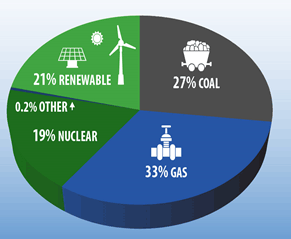On August 3, 2015, President Obama and EPA announced the Clean Power Plan – an historic and important step in reducing carbon pollution from power plants that takes real action on climate change. Shaped by years of unprecedented outreach and public engagement, the final Clean Power Plan is fair, flexible and designed to strengthen the fast-growing trend toward cleaner and lower-polluting American energy. With strong but achievable standards for power plants, and customized goals for states to cut the carbon pollution that is driving climate change, the Clean Power Plan provides national consistency, accountability and a level playing field while reflecting each state’s energy mix. It also shows the world that the United States is committed to leading global efforts to address climate change.
Nuclear power is part of an "all the above" energy strategy that supports economic growth and job creation, enhances our nation's energy security, and protects the planet for future generations. The Clean Power Plan (CPP) ensures that zero carbon nuclear power will continue to play a prominent and meaningful role in America’s energy mix.
With CPP, Nuclear Power remains Nearly 20% of the Energy Mix in 2030

EPA expects nuclear power to be a key partner in achieving the goals of the CPP. States can use new nuclear generation to help meet their Clean Power Plan goals. This includes new nuclear reactors that come on‐line, including those under construction, and existing facilities that expand their capacity (uprates).
The CPP creates incentives for nuclear energy. Nuclear energy accounts for nearly 20 percent of the power produced in the U.S., and is a reliable, carbon free generation source. The CPP provides multiple pathways and approaches for leveraging the value of clean energy in state plans, and creates incentives for clean energy technologies, including nuclear power. There are incentives to continue operation of existing nuclear units so that emissions from affected fossil-fuel fired sources will not increase from today’s levels. There are incentives to upgrade equipment and increase a unit’s capacity through an uprate, which can further offset carbon emissions from affected power plants. And there are incentives for investment in new nuclear capacity to help states meet their goals. In addition, if existing units receive operating license extensions that are accompanied by an eligible capacity uprate as a result of the relicensing process, the capacity uprate will be eligible for credit towards compliance under the Clean Power Plan.
Mass-Based Plans: Considerations for Nuclear Power
How Nuclear Power Interacts: Nuclear, like renewable energy generation and energy efficiency programs, can compete well and play an important role in mass-based plans, as increased nuclear generation can mean that fossil fuel fired units operate less and emit less CO2. There are two key ways in which a mass-based plan can encourage nuclear technologies. The first way is that, by providing incentives for nuclear power capacity additions, states can help lower emissions and make it easier and cheaper for affected power plants to meet mass-based caps.
The second way is through the creation and distribution of allowances. States implementing an allowance-based system can use nuclear power to reduce electricity generation from affected EGUs and replace it with carbon-free power. For example, states could consider using allowances to incentivize additional nuclear capacity in the following ways:
- Direct Allocation – States can allocate a portion of the allowance budget directly to nuclear power owners, who can then sell them in the allowance market.
- Allowance Auctions – States could use proceeds from allowance auctions fund clean energy like nuclear, or any other state priority.
- Allowance Set-Asides – States could reserve a quantity of allowances for allocation to certain entities for purpose of furthering a specific objective, like nuclear energy.
Rate-Based Plans: Considerations for Nuclear Power
How Nuclear Power Interacts: Nuclear, like renewable energy generation and energy efficiency programs, can compete well and play an important role in complying with rate‐based plans through the creation of emission rate credits (ERCs) from new and uprated nuclear capacity. If a state chooses to meet a rate-based goal and allows the use of ERCs, then new and uprated nuclear capacity may be eligible to receive ERCs based on zero‐emitting MWh of generation. Since an ERC is a tradable compliance instrument, it represents an asset that can be sold in the market, resulting in a monetary payment to nuclear power plant owners.
For zero and low-carbon emitting source owners, a key requirement is to plan for, implement, and document the use of best practices for evaluation, measurement and verification (EM&V). To support these efforts, the EPA has established “presumptively approvable” EM&V provisions in Section IV.D.8 of the proposed model trading rules. These provisions, when finalized, will help facility owners prepare EM&V plans and reports that they will submit to states for consideration in the subsequent ERC-issuance process. This process is expected to be relatively straightforward for nuclear facilities because they already measure and verify the (zero carbon) MWs supplied to the grid on a regular basis using a revenue quality meter as specified in the rule.
Printable version of the fact sheet:
You will need Adobe Reader to view some of the files on this page. See EPA’s About PDF page to learn more.